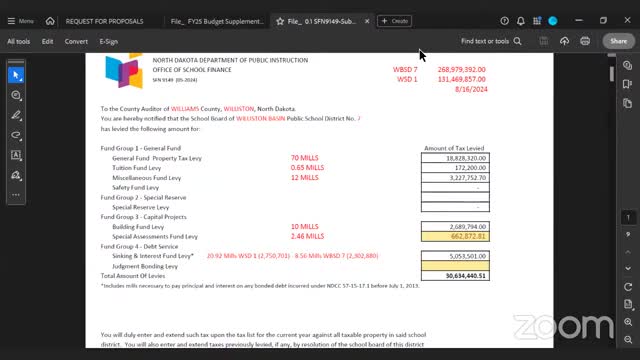School district faces funding crisis amid rising expenses
October 09, 2024 | WILLISTON BASIN 7, School Districts, North Dakota
This article was created by AI summarizing key points discussed. AI makes mistakes, so for full details and context, please refer to the video of the full meeting. Please report any errors so we can fix them. Report an error »

In a recent government meeting, officials discussed the critical implications of mill levy adjustments on future funding for the district. The conversation highlighted the need for a strategic approach to managing the district's financial landscape, particularly in light of rising expenses and the scrutiny faced by local governance.
One key point raised was the importance of focusing on the overall management of mill levies rather than getting bogged down in individual budget line items. Newly appointed official Mr. Arnold, who has been in his role for just over a month, is still familiarizing himself with the financial systems in place. This transition period is expected to come with challenges, and officials emphasized the need for patience and understanding as he navigates the complexities of the district's financial spreadsheets.
The discussion also touched on the district's outstanding debts and the limitations imposed by state regulations, which restrict access to more than 50% of the special reserve fund. This constraint complicates decision-making regarding whether to maintain or reduce mill levies, especially as the district faces a significant increase in state aid debt, which has risen by $12 million.
Budget projections indicate a substantial increase in expenses, with the district's budget rising from $60.8 million to a proposed $85 million over two years. This $25 million increase raises concerns about deferred maintenance and operational costs, prompting officials to consider the necessity of returning to taxpayers for additional funding.
As the district navigates these financial challenges, the focus remains on effective communication with the public regarding the implications of mill levy decisions and the overall financial health of the organization.
One key point raised was the importance of focusing on the overall management of mill levies rather than getting bogged down in individual budget line items. Newly appointed official Mr. Arnold, who has been in his role for just over a month, is still familiarizing himself with the financial systems in place. This transition period is expected to come with challenges, and officials emphasized the need for patience and understanding as he navigates the complexities of the district's financial spreadsheets.
The discussion also touched on the district's outstanding debts and the limitations imposed by state regulations, which restrict access to more than 50% of the special reserve fund. This constraint complicates decision-making regarding whether to maintain or reduce mill levies, especially as the district faces a significant increase in state aid debt, which has risen by $12 million.
Budget projections indicate a substantial increase in expenses, with the district's budget rising from $60.8 million to a proposed $85 million over two years. This $25 million increase raises concerns about deferred maintenance and operational costs, prompting officials to consider the necessity of returning to taxpayers for additional funding.
As the district navigates these financial challenges, the focus remains on effective communication with the public regarding the implications of mill levy decisions and the overall financial health of the organization.
View full meeting
This article is based on a recent meeting—watch the full video and explore the complete transcript for deeper insights into the discussion.
View full meeting
